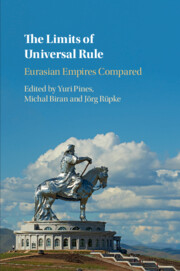Book contents
- The Limits of Universal Rule
- The Limits of Universal Rule
- Copyright page
- Contents
- Maps
- Figures
- Contributors
- Abbreviations
- Preface
- Introduction
- 1 From the Mediterranean to the Indus Valley: Modalities and Limitations of the Achaemenid Imperial Space
- 2 Limits of All-Under-Heaven: Ideology and Praxis of “Great Unity” in Early Chinese Empire
- 3 The Roman Empire
- 4 The Medieval Roman Empire of the East as a Spatial Phenomenon (300–1204 CE)
- 5 Early Islamic Imperial Space
- 6 The Mongol Imperial Space
- 7 The Territories and Boundaries of Empires
- 8 Delimiting the Realm Under the Ming Dynasty
- 9 The Expansion of the Qing Empire Before 1800
- 10 All Under the Tsar
- Index
- References
7 - The Territories and Boundaries of Empires
Ottoman, Safavid and Mughal
Published online by Cambridge University Press: 07 January 2021
- The Limits of Universal Rule
- The Limits of Universal Rule
- Copyright page
- Contents
- Maps
- Figures
- Contributors
- Abbreviations
- Preface
- Introduction
- 1 From the Mediterranean to the Indus Valley: Modalities and Limitations of the Achaemenid Imperial Space
- 2 Limits of All-Under-Heaven: Ideology and Praxis of “Great Unity” in Early Chinese Empire
- 3 The Roman Empire
- 4 The Medieval Roman Empire of the East as a Spatial Phenomenon (300–1204 CE)
- 5 Early Islamic Imperial Space
- 6 The Mongol Imperial Space
- 7 The Territories and Boundaries of Empires
- 8 Delimiting the Realm Under the Ming Dynasty
- 9 The Expansion of the Qing Empire Before 1800
- 10 All Under the Tsar
- Index
- References
Summary
The three so-called early modern Islamic empires formed in regions where the pre-Islamic Byzantine, Achaemenid and Sasanian and Mauryan and Delhi Sultanate states had originally been centered: the Bosphorous and Anatolia, the Iranian Plateau and the South Asian subcontinent. The boundaries of the Muslim-ruled Ottoman, Safavid and Mughal states were determined to a considerable degree by fixed geographic and economic realities, despite the explicit or implied universalistic pretensions of their dynasties. Individual rulers may have harbored grand ambitions, but none of these empires ever sought to destroy their imperial neighbors, but instead attempted only to occupy the marchlands between them. Thus the boundaries between the Ottomans and Safavids and the Safavids and Mughals remained largely static, even while the Ottomans occupied the Balkans, the Fertile Crescent, Egypt and North Africa, the Safavids subdued Georgia and overran western Afghanistan and the Mughals retained Kabul and eastern Afghanistan, while they bludgeoned the Deccan Sultanates into submission.
- Type
- Chapter
- Information
- The Limits of Universal RuleEurasian Empires Compared, pp. 257 - 283Publisher: Cambridge University PressPrint publication year: 2021

